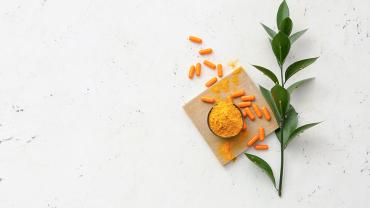
Nuclear factor erythroid 2-related factor (Nrf2) is a transcription factor associated with more than 200 genes. Nrf2 helps to modulate antioxidative metabolism, support a healthy inflammatory response, and preserve homeostasis in the presence of cellular stress. Nrf2 activation occurs through the phosphatidylinositol 3-kinase (PI3K)/protein kinase (Akt) signaling pathway. Certain botanicals have been shown in recent research to support the Nrf2 pathway.
Curcumin is a polyphenolic compound derived from turmeric (Curcuma longa). It is used both medicinally and as a spice. Curcumin and its derivative curcuminoids have been shown to support the activation of the Nrf2 pathway and its signaling gene (NQO1) in laboratory studies. Through the activation of Nrf2, curcumin has been shown to help decrease certain pro-inflammatory cytokines such as interleukin-6 and tumor necrosis factor-ɑ and help inhibit abnormal levels of serum malondialdehyde (MDA). Curcumin may also help increase the concentration of glutathione in liver mitochondria and help increase the expression of phase II detoxifying genes. Curcumin has been shown to help inhibit reactive oxygen species (ROS)-mediated insulin resistance through its ability to activate the Nrf2 signaling pathway.
Resveratrol is a compound found in grape skin, dark berries, and peanuts, and it is known for its supportive role in cardiovascular and cellular health and for its antioxidative status. It has also been shown to target Nrf2 activation; downstream effects include helping support antioxidant protein expression, mitochondrial coupling, and astrocyte activity. Nrf2 is abundant in astrocytes and helps support their ability to modulate antioxidants in neurons.
Pterostilbene is a molecule found in blueberries and it’s structurally similar to resveratrol. It has been shown to support cardiovascular health, cellular function, a healthy gut microbiome, and a healthy inflammatory response.* Research also indicates that pterostilbene may support the Nrf2 pathway, healthy glutathione levels, and antioxidative status. It has been shown to help prevent the generation of ROS and help reduce oxidative injury induced by high glucose levels in hippocampal neuronal cells through the activation of the Nrf2 pathway. It also increases superoxide dismutase and glutathione activation through the Nrf2 signaling pathway.
In human cornea epithelial cells, the administration of pterostilbene was shown to help reduce MDA and other biomarkers associated with oxidative stress. A clinical trial reported a significant increase in serum total antioxidant status in healthy older individuals in the presence of pterostilbene administration for 4 weeks.
More research is needed before clinical conclusions can be made, although certain botanicals may help support Nrf2 activity. They may also support antioxidative status and a healthy response to inflammation.
By Colleen Ambrose, ND, MAT